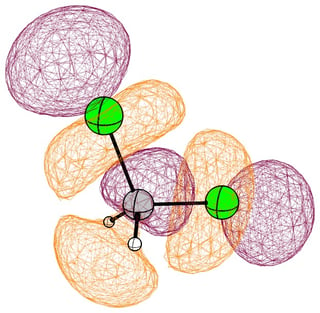In the book Organic Chemistry by J. Clayden, N. Greeves, S. Warren, and P. Wothers I found the following reasoning:
You may have wondered why it is that, while methyl chloride (chloromethane) is a reactive electrophile that takes part readily in substitution reactions, dichloromethane (DCM) is so unreactive that it can be used as a solvent in which substitution reactions of,other alkyl halides take place. You may think that this is a steric effect: Indeed, $\ce{Cl}$ is bigger than $\ce{H}$. But $\ce{CH2Cl2}$ is much less reactive as an electrophile than ethyl chloride or propyl chloride: there must be more to its unreactivity. And there is: Dichloromethane benefits from a sort of 'permanent anomeric effect.' One lone pair of each chlorine is always anti-periplanar to the other $\ce{C–Cl}$ bond so that there is always stabilization from this effect.
So, in MO-terms the situation would look something like this.

The reasoning looks plausible to me. The interaction between the free electron pair on $\ce{Cl}$ and the $\sigma^{*}$ orbital of the neighboring $\ce{C-Cl}$ bond, which would be the LUMO of DCM, lowers the energy of the free-electron-pair-orbital, thus stabilizing the compound and it raises the energy of the LUMO, thus making DCM less reactive towards nucleophiles.
But how important is this anomeric effect actually for explaining the unreactiveness of DCM toward nucleophiles, especially compared to the steric effect? And how important is the steric effect actually: Is the steric hindrance exerted by the second $\ce{Cl}$ in $\ce{CH2Cl2}$ really that much larger than the steric hindrance exerted by the methyl group in $\ce{CH3CH2Cl}$ (which is a good electrophile for $\mathrm{S_N2}$ reactions)?
I'm a little skeptical because if this anomeric effect was very important I would have expected that the $\ce{C-Cl}$ bond length in DCM would be slightly higher than in methyl chloride because there should be some transfer of electron density from the free electron pair into the antibonding $\sigma^{*}$ orbital, which should weaken the $\ce{C-Cl}$ bond. But the actual bond lengths don't show this. They show rather the contrary:
$$\begin{array}{c|c} \hline \text{Species} & \text{Average }\ce{C-Cl}\text{ bond length / Å} \\ \hline \ce{CH3Cl} & 1.783 \\ \ce{CH2Cl2} & 1.772 \\ \ce{CHCl3} & 1.767 \\ \ce{CCl4} & 1.766 \\ \hline \end{array} $$ (source: Wikipedia)
Now, I know that the stronger polarization of the $\ce{C}$ atomic orbitals in di-, tri-, and tetrachlorinated methane as compared to methyl chloride (due to the electronegativity of $\ce{Cl}$) should lead to an overall strengthening of the $\ce{C-Cl}$ bonds in those compounds. But I would have expected a trend that would show only a slight decrease (or maybe even an increase) of bond length when going from methyl chloride to DCM and then a more pronounced decrease when going from DCM to chloroform followed by a similar decrease when going from chloroform to tetrachloromethane. But instead the polarization effect seems to only slightly increase on adding more chlorine atoms.












